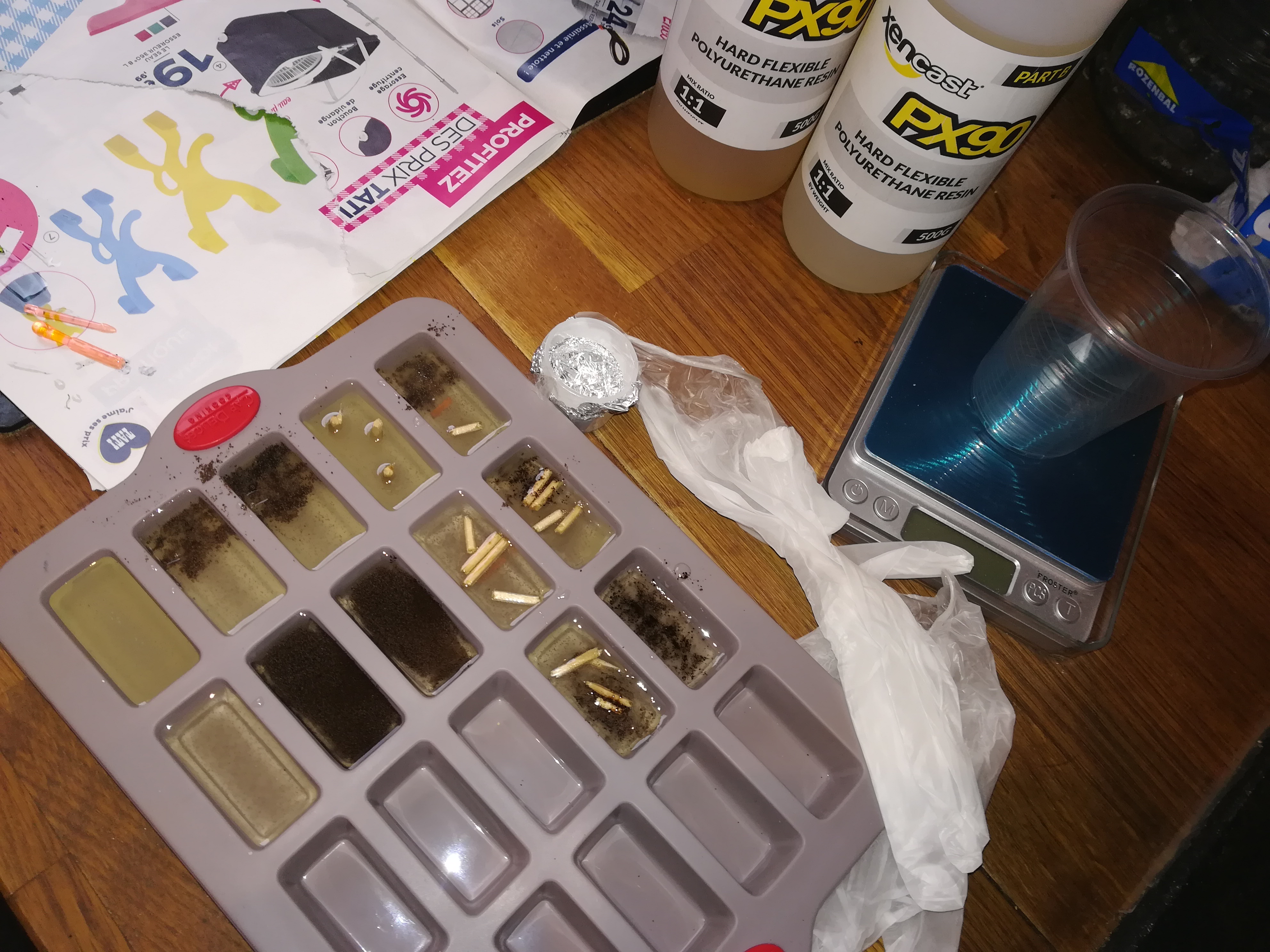-
PU phantoms
04/01/2018 at 17:41 • 0 commentsDoing a bit of research, I found that PU could be used for nice phantoms, having acoustic impedance close to that of water.
I tried two types (hard and soft, respectively PX90 and PX30) - and casted them into a silicon mold for financiers.
Tried different layers of hard/soft, including some coffee grounds for diffusers.. curious to see that these will yield.
![]()
Really curious to see what they'll give.
-
Another DIY gel... and a video =)
06/07/2016 at 18:06 • 0 commentsThanks to Janice, here's a cool recipe for ultrasound gel.
I messed with the recipe awhile and came up with a very nice slightly caramel tinged ultrasound gel this way:
- Mix 2 teaspoons of guar gum with 1-2 teaspoons of salt. (The amount of salt isn't vitally important since it is just added to keep the guar gum from clumping. Using slightly less than a teaspoon of salt per 2 cups makes a gel with which is isotonic, which would be ideal for use near eyes or other mucus membranes or on open wounds).
- Boil two cups of water.
- Slowly sprinkle the guar gum/salt mixture into the boiling water while stirring vigorously with a fork or whisk.
- Boil for about 1-2 minutes until thick and well mixed.
- Cool before using. Save lives.
And the movie :
-
Interesting read on DIY locally-sourced ultrasound gel
06/07/2016 at 14:54 • 0 comments"This paper describes design of a low cost, ultrasound gel from local products applying aspects of Human Centered Design methodology. A multidisciplinary team worked with clinicians who use ultrasound where commercial gel is cost prohibitive and scarce. The team followed the format outlined in the Ideo Took Kit. Research began by defining the challenge "how to create locally available alternative ultrasound gel for a low-resourced environment? The "End-Users," were identified as clinicians who use ultrasound in Democratic Republic of the Congo and Ethiopia. An expert group was identified and queried for possible alternatives to commercial gel."
#BOP #Jugaad #JusteCool
Source: http://journals.plos.org/plosone/article/asset?id=10.1371%2Fjournal.pone.0134332.PDF
-
Initial Builds/Tests
05/03/2016 at 14:04 • 0 commentsOne of the identified issues with current DIY phantoms is that they're essentially made of growth medium (gelatin in water/agar). A well kept standard DIY phantom may last 10 days before it is overcome by mold. This can be enhanced a little bit by wiping it down with bleach (other cleaners appeared to break down the phantom), but it is ultimately a losing battle.
Breakdown is a pretty big issue as the surface of the phantom is critically important. Small, almost invisible imperfections, can cause apparently massive surface artifacts in an ultrasound. Two types of imperfections are really intrusive, but they're ultimately due to the same issue: Boundary Transition. Every time sound crosses a transition between objects with differing levels of sound transparency (speed of sound through the medium), some of the sound is reflected. The ultrasound imager relies on these reflections to visualize (it's literally the principle behind ultrasound imaging), but starts to have difficulty visualizing objects beyond the transition (less transmitted signal to utilize).
For this reason, surface imperfections are to be avoided as much as possible.
So, to start, I'm going to look at biocidial, but relatively innocuous substances to make the phantoms. On the list are bleach and vinegar, added to the water.
-
Some resources and articles on materials
04/29/2016 at 09:05 • 0 commentsSome articles:
- https://deepblue.lib.umich.edu/bitstream/handle/2027.42/38198/1870230413_ftp.pdf?sequence=1
- http://www.ncbi.nlm.nih.gov/pmc/articles/PMC3506077/
- http://www.sciencedirect.com/science/article/pii/S2211419X15001111
On materials, we have :
- http://www.ondacorp.com/images/Plastics.pdf
- http://www.ondacorp.com/images/Rubbers.pdf
- http://www.signal-processing.com/us_data.html
- http://www.signal-processing.com/us_data_p.html
Some videos
 kelu124
kelu124